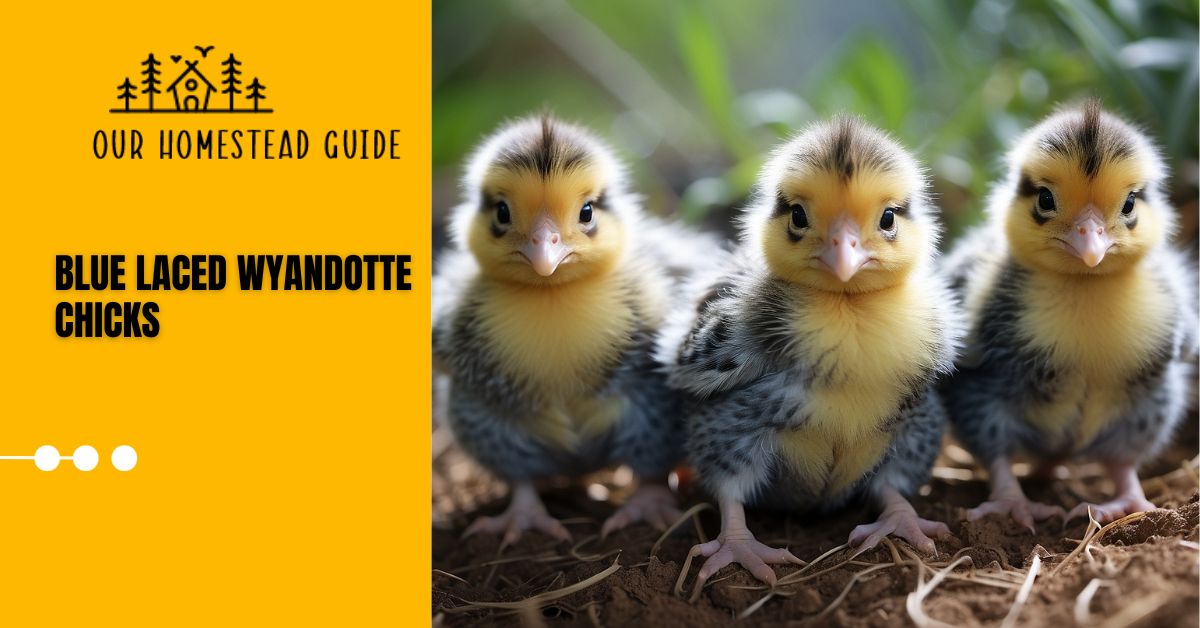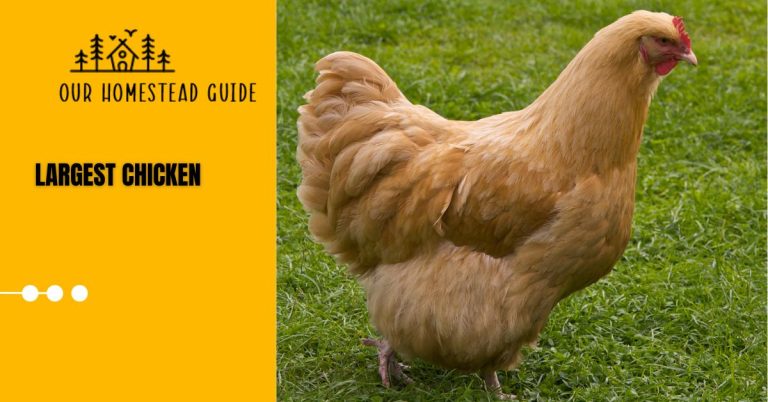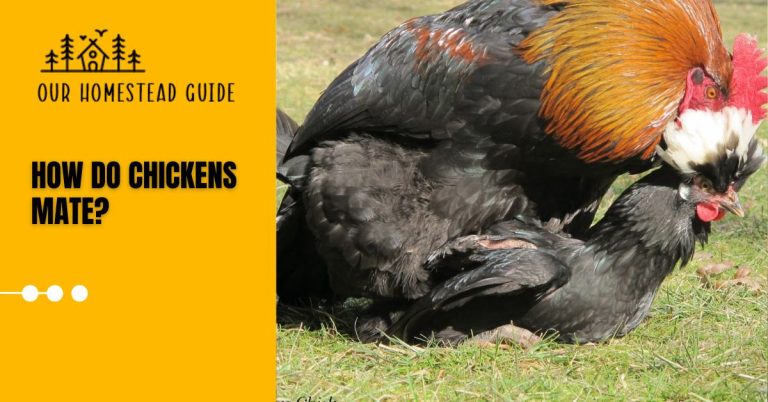Blue Laced Wyandotte Chicks: Traits and Care Complete Guide
A brood of blue-laced Wyandotte chicks tumbles out of their coop with a flurry of fluffy feathers. With button eyes full of wonder, each small fluffball has a gorgeous tapestry of azure lacework against a porcelain background.

With a charming clumsiness, they explore their brand-new environment as they peck and chirp their way over the coop floor. These little marvels, whose vivid personalities match the brightness of their feathers, add a touch of quirky charm to any garden, much like small porcelain dolls come to life.
Blue Laced Wyandotte Chicks overview

| Aspect | Description |
|---|---|
| Breed Name | Blue Laced Wyandotte |
| Chick Appearance | Fluffy and downy with a mix of blue and silver laced feathers |
| Coloration | Blue with laced silver edges |
| Temperament | Generally docile and friendly |
| Purpose | Dual-purpose breed (meat and eggs) |
| Egg Production | Good egg layers, producing brown eggs |
| Hardiness | Cold-hardy, suitable for various climates |
| Broodiness | Can exhibit broody behavior |
| Size | Medium-sized chicken breed |
| Laying Frequency | Approximately 200-220 eggs per year |
| Growth Rate | Moderate growth rate |
| Special Characteristics | Unique blue laced feather pattern |
| Feeding | Standard chick starter feed, transitioning to grower feed |
| Space Requirements | Provide adequate space for roaming and scratching |
| Health Considerations | Monitor for common chick health issues; provide vaccinations |
| Common Uses | Eggs for consumption, ornamental purposes |
Understanding the Breed:
- One kind of Wyandotte chicken is called Blue Laced Wyandottes.
- originated in Wisconsin and New York State in the late 1800s.
- Easily identified by their buff hue and blue feather lace.
- They can have blue, splash, and black children.
Setting Up the Brooder:
- Set up a brooder with enough room, bedding, and a heat source.
- For the first week, keep the temperature at around 95°F (35°C); after that, drop it by 5°F (2.8°C) per week until they have all of their feathers.
Feeding:
- Select chick starter feed of the highest caliber, with 18–20% protein.
- Always have clean, fresh water available.
- Add grit gradually to aid with digestion.
Lighting:
For the first several weeks, give a steady supply of light—roughly 18 to 20 hours per day. To mimic the natural cycles of day and night, gradually alter the light schedule.
Health Care:
Watch the chicks closely for any indications of sickness or discomfort.
Should any health concerns emerge, speak with a veterinarian.
Vaccinate by the suggested timetable.
Transition to Coop:
The chicks can be relocated to a coop when they are completely feathered and able to control their body temperature, which is typically between 6 to 8 weeks.
Coop Setup:
Provide a coop with nesting boxes that is well-ventilated.
Make sure you are safe from wolves.
Cover the coop with hay or straw.
Egg Production:
Large, light brown eggs are laid by Blue Laced Wyandottes.
Make sure nesting boxes are tidy and cozy.
Climate Considerations:
It is commonly known that blue-laced Wyandottes thrive in chilly areas.
If more heat is required during extremely cold weather, provide it.
Monitoring Growth:
Keep tabs on your birds’ development. Hens grow to weigh around 6.5 pounds, while roosters usually reach 8.5 pounds.
Blue Laced Wyandotte Chicks History
The beautiful and alluring Blue Laced Wyandotte chicken breed is distinguished by its rich red feathers with subtle blue lacing. These hens are grown for both their meat and their eggs, making them dual-purpose animals.

They are also well-liked as display birds because of their unique conformation and coloring. It is thought that the Blue Laced Red Wyandotte Rooster came from the United States in the late 1800s. It is believed to have originated from a cross between the Dominique, Silver Spangled Hamburg, and Dark Brahma.
After being initially standardized in 1889, the breed rose to prominence as one of the most well-liked chicken breeds in the US.
Blue Laced Wyandotte Chicks Appearance
The remarkable look of the medium-sized Blue Laced Wyandotte chicken is attributed to its rich red plumage with subtle blue lacing. This produces a strikingly contrasted pattern that distinguishes this breed from others.
Size:
The roosters of Blue Laced Red Wyandottes are around 8.5 pounds in weight, while the hens are about 6.5 pounds. These birds are categorized as medium-sized.
Type of Body:
Their wide chest and deep keel give them a well-rounded physique. Their tail is carried at a medium inclination, and their back slopes slightly.
Plumage:
The plumage of the Blue Laced Red Wyandotte is its most distinctive characteristic. Their base color is a rich crimson, and each feather is delicately outlined in blue lace. The wings, tail, and neck have the most noticeable lacing.
Head:
They have a single comb with several tiny points, called a rose comb. Their beak is yellow, while their wattles and earlobes are crimson.
Eyes:
Their eyes are the hue of reddish-bay.
Blue Laced Wyandotte Chicks Temperament
Wyandottes are regarded as calm, amiable hens. They get along well with humans, especially kids because they don’t get offended very often. If chicks get used to being handled at an early age, they don’t dislike it, but they’re not often referred to as “lap chickens.” Although they don’t mind being with people, they are not suitable as family pets.
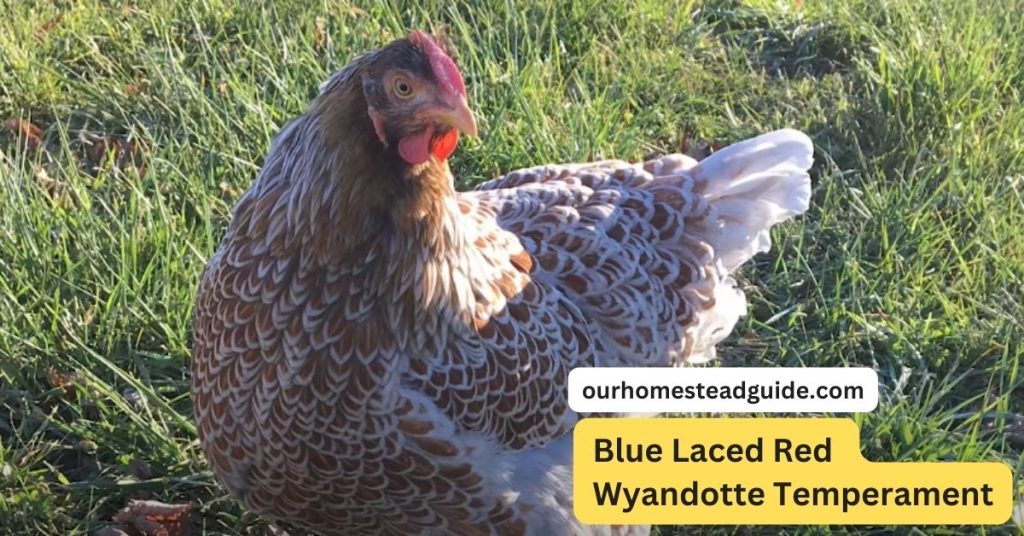
Because of their great degree of adaptability, these birds will happily roam free or be kept in confinement as long as they have access to their fundamental need. These birds are ideal for novice chicken owners due to their unique personalities.
Broodiness
Although they don’t seem to go broody, these chickens may be excellent moms. They will sit on eggs and keep them warm until they hatch, and they will take any egg put beneath them as their own. In this manner, you may assist the eggs hatch without needing to use an incubator if you so want.
Although this behavior could be advantageous for keepers who want to breed their hens, the fluffy feathers of Blue Laced Red Wyandottes might cause infertility issues. Thus, it may be challenging to breed them.
Noise Levels
Wyandottes are often quiet and serene people. However, some have been known to be chatty anyway, thus it varies depending on the particular chicken. To ensure that your hens don’t annoy anyone, it’s a good idea to keep them far away from neighbors because you never know how talkative these birds will be.
Compared to hens, roosters tend to be chattier and may create crowing sounds in the morning. Therefore, you might want to pass on buying roosters if you don’t intend to breed your chickens.
Here are some of the specific noise levels you can expect from Blue Laced Red Wyandottes:
- Crowding: To mark their territory and draw potential mates, roosters will crow at first light. A Blue Laced Red Wyandotte rooster’s crowing normally reaches a decibel range of 60–70, which is comparable to a normal conversation.
- Laughing: When they lay eggs, hens will cackle. A Blue Laced Red Wyandotte hen’s cackling usually reaches between 80 and 90 decibels, making it roughly the same volume as a vacuum cleaner.
- Cooing and clucking: Clucking and cooing are the noises that chickens use to communicate with one another. These noises are normally between thirty and forty decibels loud, which is comparable to a whisper.
Here are some more suggestions to help you quiet your Blue Laced Red Wyandottes:
At night, keep your roosters indoors. This will stop them from crowing in the morning.
Make sure your hens have lots of room and stimulation. Their urge to create noise will decrease as a result of this helping to keep them content and busy.
Inform your neighbors about your hens through conversation. This will assist in preventing any miscommunications or disputes.
Do Blue Laced Wyandottes Chicks Get Along with Other Animals?
Indeed, Blue Laced Red Wyandottes are well-known for having a calm, amiable demeanor that makes them get along with a wide range of other animals. They can even get along with well-behaved dogs and cats. Generally speaking, they are not hostile toward other hens or pets.
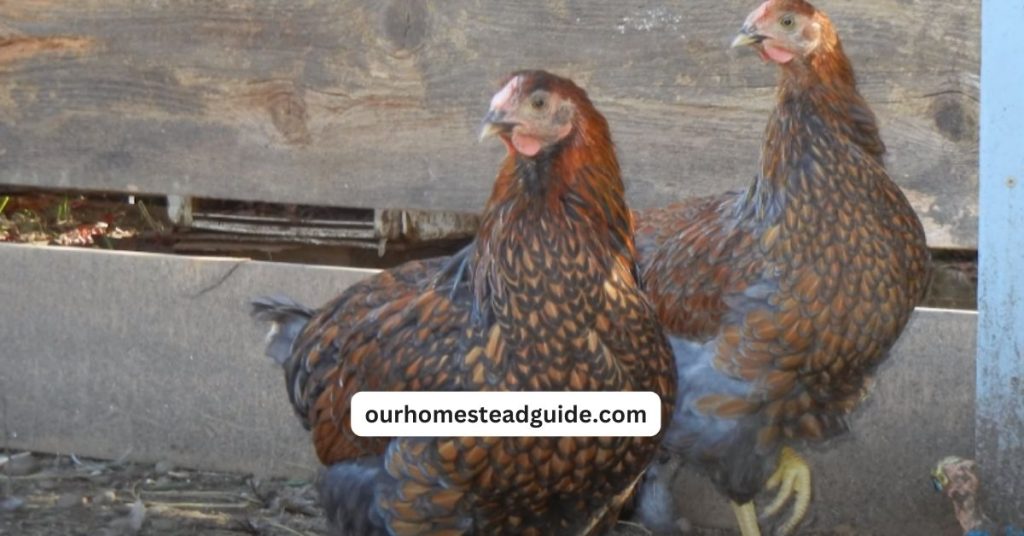
The following are particular instances of how Blue Laced Wyandottes Chicks get along with different animals:
Additional hens:
They may be raised in mixed flocks with different breeds and are typically not hostile toward other chickens. To make sure that everyone gets along, it’s crucial to progressively and carefully introduce new hens to an established flock.
Dogs:
Well-mannered dogs can get along with Blue Laced Red Wyandottes, particularly if the dog has been around hens at a young age. To make sure that the dog does not chase or hurt the chickens, it is crucial to watch over interactions between dogs and hens.
Cats:
Well-mannered cats can also get along with Blue Laced Red Wyandottes. Nonetheless, since cats are innate bird hunters, it’s crucial to monitor how they interact with chickens.
Additional animals:
In addition, Blue Laced Red Wyandottes get along well with other animals including goats, guinea pigs, and rabbits. It’s crucial to gradually and carefully introduce new pets to hens, just like you would with other animals.
All things considered, Blue Laced Red Wyandottes are an adaptable breed that gets along with a wide range of different creatures. In a home with many species, they may be a wonderful addition with the right socialization and guidance.
The following are some more pointers for housing Blue Laced Wyandottes Chicks with other animals:
- Sheep should be progressively introduced to new animals under close observation.
- Give every animal plenty of room to explore and socialize.
- Keep an eye on how the hens and other animals are interacting to make sure everyone is getting along securely.
- To avoid disputes, provide hens and other animals their own feeding and watering stations.
Care Requirements for Blue Laced Wyandotte Chicks
Due to their ease of maintenance, Blue Laced Red Wyandottes are a great option for both seasoned poultry aficionados and backyard chicken owners. They are resilient and climate-adaptable birds that can live in many different environments.
Housing
Cooperation: Give your Blue Laced Red Wyandottes access to a draft-free, well-ventilated coop. The birds should be able to walk around in the coop with ease. Generally speaking, you should provide each chicken with at least 4 square feet of area.
Bars that Roose: To provide the birds ample room to stretch out, place roosting bars at least 8 to 10 inches apart. To avoid foot injury, Roosting bars should be composed of a smooth material.
Nest Boxes: For every four to five hens, provide one nest box. Nesting boxes ought to be tucked away in a peaceful section of the coop.
Feeding
Trade Feed: Make sure to give your Blue Laced Red Wyandottes premium commercial chicken dinner. The food needs to be suitable for their age and life stage.
Grit: Grit is an insoluble substance that aids in the digestion of food, therefore giving it to your hens. Grit is available at most pet supply stores.
Clean Water: Always give your hens access to clean, fresh water. Every day, and more often in hot weather, change the water.
Take Care
Tidiness: To keep bacteria from growing and to get rid of droppings, clean the coop often.
Protection Against Predators: Securing your hens’ coop and run will help keep them safe from predators. To prevent predators from entering, use netting, fences, and other deterrents.
Monitoring Health: Keep an eye out for symptoms of disease in your hens, such as odd droppings, changes in appetite, or lethargy. Should you be concerned about your hens’ health, speak with a veterinarian.
Extra Advice
- To maintain your hens nice and tame, give them daily attention.
- To keep your hens occupied, give them lots of stimulation, such as toys and scratch boxes.
- If at all feasible, let your hens roam free to browse for food and exercise.
Your Blue Laced Red Wyandottes will flourish and bring you years of pleasure if you give them the right care and attention.
How to Breed Blue Laced Wyandottes Chicks
Although breeding Blue Laced Red Wyandottes (BLRWs) may be a fulfilling experience, it’s important to comprehend the procedure and take a number of considerations into account before starting this trip. Here’s a starting point guide:
Selection:
Breeding Stock: Select robust, healthy birds (about a year old) with the clear lacing, barring, and feather quality that are desirable in BLRWs. Refrain from breeding birds that have defects or a poor reproductive history.
Genetics: Recognize the intricate genetic makeup of BLRWs. They are carriers of the wheaten (Wh), black (e), and blue lacing (Bl) genes. Pairs engaged in breeding can yield more than only BLRW chicks. Speaking with a breeder or hatchery knowledgeable in BLRW genetics may be beneficial.
Mating and Hatching:
For maximum fertility, keep the natural mating ratio of one rooster to six or eight hens.
Setting: Provide a roomy cage with access to dust baths and nesting boxes. Ascertain enough airflow and tidy bedding.
Egg Gathering and Incubation: Gather eggs every day and keep them somewhere cold and dry for a maximum of one week before putting them through the incubation process. Throughout the incubation phase (about 21 days), use a dependable incubator and keep the temperature and humidity levels at the right levels.
Chick Care:
Brooder Setup: Assemble a brooder that has enough room, a heat source (95°F at first, lowering progressively), and suitable bedding.
Feeding: Give your chicks a premium beginning meal that is strong in protein (18–20%). Provide clean water and then progressively add grit to aid with digestion.
Monitoring: Keep a watchful eye out for any symptoms of sickness or discomfort in the chicks. See a veterinarian if necessary.
Development of Feather and Color: Chicks have brown or blue down and are buff in color. It takes many months for the whole color to emerge, with the blue lacing beginning to show around 6 to 8 weeks.
Transition to Coop: After they are completely feathered and able to control their body temperature, which normally happens in 6 to 8 weeks, chicks may go into a well-ventilated, predator-proof coop with nesting boxes.
Additional Tips:
- Keep up proper hygiene to stop the spread of illness.
- Vaccinate your chicks in accordance with the suggested timetable.
- For the benefit of the chicks, provide enrichment activities like dust baths and spaces for them to scratch.
- Have patience, since it may require some time and selective breeding techniques to create a breeding line and produce consistently BLRW offspring.
Production of Eggs
About four eggs are laid weekly by Blue Laced Red Wyandottes, for a total of over 200 eggs a year. Wyandottes lay eggs all year round because they are acclimated to the cold, unlike many other chickens that stop laying in the winter.
Wyandottes typically begin producing eggs between 16 and 20 weeks of age. Big brown eggs are what they lay.
Are Blue Laced Wyandottes Chicks the Right Chickens for You?
It is up to you to decide if Blue Laced Red Wyandottes are the best hens for your requirements and interests. Here are some things to think about:
Characteristics:
Because of their gentle and amiable nature, Blue Laced Red Wyandottes are a great option for households with young children. Additionally, they are not too difficult to manage or train.
Manufacturing:
As dual-purpose chickens, Blue Laced Red Wyandottes are raised for both their meat and their eggs. Their flesh is soft and tasty, and they lay between 200 and 250 eggs annually.
Climate tolerance:
Hardy and versatile, Blue blue-laced red Wyandotte hens may flourish in a range of temperatures. They work effectively in both hot and cold climates.
All things considered, hen keepers searching for a sociable, productive, and attractive breed could choose Blue Laced Red Wyandottes. They may flourish in a range of conditions and are generally simple to maintain.
The following table lists the benefits and drawbacks of owning Blue Laced Red Wyandottes:
| Pros | Cons |
|---|---|
| Friendly and docile temperament | Can be somewhat shy |
| Good egg production | Not as prolific layers as some other breeds |
| Flavorful and tender meat | Can be prone to broodiness |
| Hardy and adaptable | Require a spacious coop |
| Striking appearance | Can be difficult to find |
Finding a trustworthy breeder and doing some study on the Blue Laced Red Wyandotte breed are both advised if you’re thinking about introducing some to your flock. Blue Laced Red Wyandottes may be fantastic additions to your backyard coop if given the right care.
Most Frequently Asked Questions!
Q: What makes Blue Laced Wyandotte chicks unique?
Embroidered in Blue Poultry aficionados have a strong attraction to Wyandotte chicks because of their unusual blue coloring and interwoven silver borders on their feathers.
Q: Are Blue Laced Wyandotte chicks suitable for beginners?
Indeed, most people agree that Blue Laced Wyandotte chicks are suited for novices. They are an excellent option for first-time poultry owners because of their amiable disposition and ease of maintenance.
Q: How do I care for Blue Laced Wyandotte chicks?
Make sure they have access to clean water, give them a balanced beginning meal, keep an eye on their health, and provide a warm and safe brooding habitat. Switch over gradually to grower feed as they become bigger.
Q: Are Blue Laced Wyandotte chicks good egg layers?
Indeed, Blue Laced Wyandottes lay well; they usually lay brown eggs. They are regarded as a breed with two purposes, good at producing both meat and eggs.
Q: Do Blue Laced Wyandotte chicks require special housing or space?
They don’t have very particular needs when it comes to housing, but it is crucial to provide a safe coop with enough room for them to walk around and scratch. Although they are often resistant to cold, adequate shelter is crucial.
Q: Are Blue Laced Wyandotte chicks prone to any health issues?
The Blue Laced Wyandotte chicken breed is prone to typical poultry health problems, just like any other breed. A clean living environment, immunizations, and routine health examinations can all help avoid issues.
Q: How do I identify the gender of Blue Laced Wyandotte chicks?
Early on, identifying one’s gender might be difficult. Males often have bigger combs and wattles as they become older, and females could get more rounded bodies. Moreover, feather patterns might offer hints.
Q: Can Blue Laced Wyandotte chicks be kept in mixed flocks?
In general, Blue Laced Wyandottes get along nicely with different varieties of chickens. Gradually expose them to a mixed flock, and keep an eye on their relationships to make sure they live in harmony.
Q: Do Blue Laced Wyandotte chicks require any special grooming or maintenance?
Regular grooming is not required, but maintaining a clean living space, giving them a healthy diet, and looking for evidence of mites or other parasites are crucial parts of maintenance.
Q: Where can I purchase Blue Laced Wyandotte chicks?
Chicks of the Blue Laced Wyandotte breed can be obtained from respectable breeders, poultry exhibitions, or breed-specific hatcheries. Make sure the provider you select places a high priority on the health and welfare of the chicks.
Conclusion:
With their eye-catching laced feathers of blue and silver, Blue Laced Wyandotte chicks are a popular option for novice and seasoned poultry enthusiasts alike. They are friendly, multipurpose birds that enhance the visual appeal of any flock.

